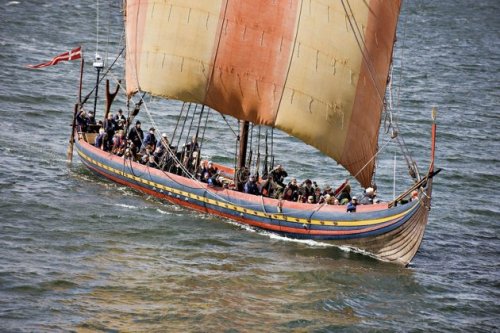Ancient tales of Norse mariners using mysterious sunstones to navigate the ocean when clouds obscured the Sun and stars are more than just legend, according to a study published Wednesday.
Over 1,000 years ago, before the invention of the compass, Vikings ventured thousands of kilometres from home toward Iceland and Greenland, and most likely as far as North America, centuries ahead of Christopher Columbus.
Evidence show that these fearless and fearsome seamen navigated by reading the position of the Sun and stars, and through an intimate knowledge of landmarks, currents and waves.
But how they could voyage long distances across seas at northern latitudes often socked in by light-obscuring fog and clouds has remained an enigma.
Enter the sunstone.
While experts have long argued that Vikings knew how to use blocks of light-fracturing crystal to locate the Sun through dense clouds, archeologists have never found hard proof, and doubts remained as to exactly what kind of material it might be.
An international team of researchers led by Guy Ropars of the University of Rennes in Brittany, marshalling experimental and theoretical evidence, says they have the answer.
Vikings, they argue, used transparent calcite crystal -- also known as Iceland spar -- to fix the true bearing of the Sun, to within a single degree of accuracy.
This naturally occurring stone has the capacity to "depolarise" light, filtering and fracturing it along different axes, the researchers explained.
Here's how it works: If you put a dot on top of the crystal and look through it from below, two dots will appear.

"Then you rotate the crystal until the two points have exactly the same intensity or darkness. At that angle, the upward-facing surface indicates the direction of the Sun," Ropars explained by phone.
"A precision of a few degrees can be reached even under dark twilight conditions.... Vikings would have been able to determine with precision the direction of the hidden Sun."
The human eye, he added, has a fine-tuned capacity to distinguish between shades of contrast, and thus is able to see when the two spots are truly identical.
The recent discovery of an Iceland spar aboard an Elizabethan ship sunk in 1592 -- tested by the researchers -- bolsters the theory that ancient mariners were aware of the crystal's potential as an aid to navigation.
Even in the era of the compass, crews might have kept such stone on hand as a backup, the study speculates.
"We have verified ... that even only one of the cannons excavated from the ship is able to perturb a magnetic compass orientation by 90 degrees," the researchers wrote.
"So, to avoid navigation errors when the Sun is hidden, the use of an optical compass could be crucial even at this epoch, more than four centuries after the Viking time."
The study appeared in Proceedings of the Royal Society A: Mathematical and Physical Sciences, a peer-reviewed journal published by Britain's de facto academy of science, the Royal Society.
<한글기사>
바이킹, '신비의 수정'으로 항해..사실인듯
바이킹이 구름이나 안개가 낀 날에도 '선스톤'(sunstone) 이라는 특수한 수정을 이용해 태양의 위치를 찾아 항해했다는 이야기는 단지 전설이 아니라 사실을 가능성이 있다는 연구결과가 나왔다.
프랑스 렌대학 연구팀은 2일 발표한 연구논문을 통해 바이킹이 빙주석(氷洲石)으로 불리는 무색투명의 방해석(方解石)을 이용해 태양의 위치를 찾아내 항해에 이용했을 것이라고 주장했다.
바이킹은 나침반이 없었던 1천여년 전에 천문지식을 바탕으로 북미대륙까지 항해했다는 여러 증거가 발견됐지만 태양 위치 파악이 힘든 흐린 날에는 어떻게 위치를 파악해 항해해 나갔는지에 대해서는 여러 추정만이 있을 뿐이었다.
고대 전설은 바이킹이 선스톤이라는 신비한 수정을 항해에 이용했다고 전하고 있지만 아직까지 선스톤의 정체와 이를 뒷받침할 확실한 고고학적 유물은 발견되지않은 상태였다.
그러나 연구팀은 편광기능이 있는 빙주석과 음영과 명암을 구분하는 정교한 능력을 갖춘 인간의 눈만으로 흐린 날에도 태양의 위치를 파악할 수 있다면서 실험적, 이론적 증거들을 종합할 때 바이킹도 빙주석을 이용해 항해했을 것이라고 추론했다.
빙주석 윗면에 점을 표시해 놓고 아래쪽에서 쳐다보면 표시한 점이 2개로 보이는데 빙주석을 돌려가면서 이 2개의 점이 같은 빛의 강도를 보이는 지점을 찾으면 그 각도에서 위쪽 면이 태양의 방향이라는 것이다.
연구팀은 바이킹이 빙주석을 이용해 어두운 상황에서도 상당히 정확하게 태양의 방향을 파악했을 것이라면서 1592년 침몰 선박 잔해에서 빙주석이 발견됐다는 사실은 나침반이 발명된 이후에도 선원들이 빙주석을 비상장비로 사용했을 가능성을 보여주는 것이라고 부연했다.








![[Weekender] Geeks have never been so chic in Korea](http://res.heraldm.com/phpwas/restmb_idxmake.php?idx=644&simg=/content/image/2024/05/16/20240516050845_0.jpg&u=)








![[Herald Interview] Byun Yo-han's 'unlikable' character is result of calculated acting](http://res.heraldm.com/phpwas/restmb_idxmake.php?idx=652&simg=/content/image/2024/05/16/20240516050855_0.jpg&u=)
